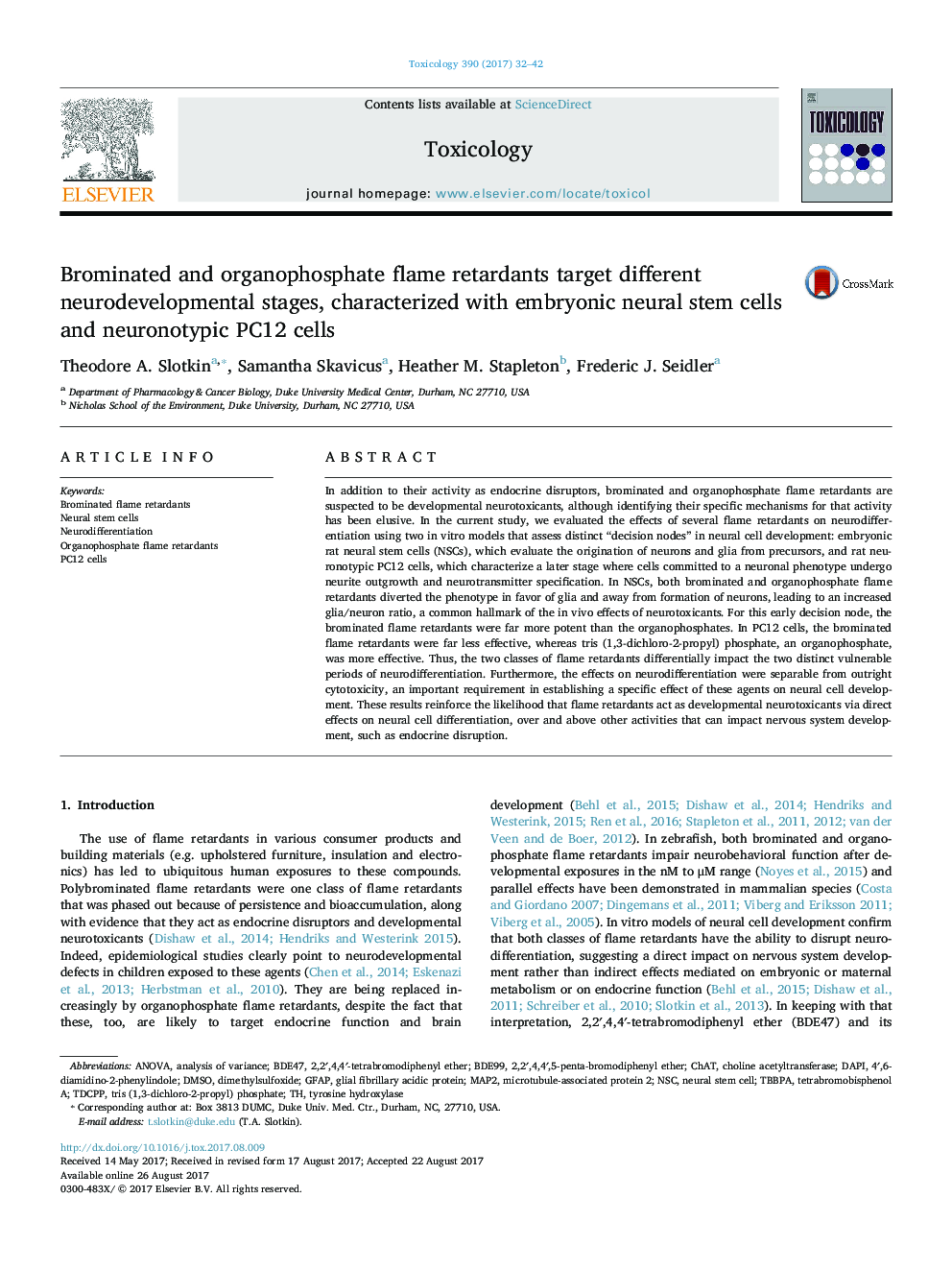| کد مقاله | کد نشریه | سال انتشار | مقاله انگلیسی | نسخه تمام متن |
|---|---|---|---|---|
| 5561686 | 1562282 | 2017 | 11 صفحه PDF | دانلود رایگان |
عنوان انگلیسی مقاله ISI
Brominated and organophosphate flame retardants target different neurodevelopmental stages, characterized with embryonic neural stem cells and neuronotypic PC12 cells
دانلود مقاله + سفارش ترجمه
دانلود مقاله ISI انگلیسی
رایگان برای ایرانیان
کلمات کلیدی
BDE47TDCPPtetrabromobisphenol ANSCGFAPMAP2TBBPADAPI2,2′,4,4′-Tetrabromodiphenyl ether - 2،2 '، 4،4'-تتررومودیفنیل اتر4′,6-diamidino-2-phenylindole - 4 '، 6-دیامیدینو-2-فنیلینولDMSO - DMSOBrominated flame retardants - بازدارنده های شعله برومندanalysis of variance - تحلیل واریانسANOVA - تحلیل واریانس Analysis of variancetyrosine hydroxylase - تیروزین هیدروکسیلازDimethylsulfoxide - دیمتیل سولفواکسیدPC12 cells - سلول های PC12Neural stem cell - سلول های بنیادی عصبیNeural stem cells - سلولهای بنیادی عصبیNeurodifferentiation - عصب عصبیOrganophosphate flame retardants - عقب اندازهای شعله ورتوفسفاتGlial fibrillary acidic protein - پروتئین اسیدی فیبریلاسیون گلایالmicrotubule-associated protein 2 - پروتئین مرتبط با میکروتوبول 2ChAT - چتcholine acetyltransferase - کولین استیل ترانسفراز
موضوعات مرتبط
علوم زیستی و بیوفناوری
علوم محیط زیست
بهداشت، سم شناسی و جهش زایی
پیش نمایش صفحه اول مقاله

چکیده انگلیسی
In addition to their activity as endocrine disruptors, brominated and organophosphate flame retardants are suspected to be developmental neurotoxicants, although identifying their specific mechanisms for that activity has been elusive. In the current study, we evaluated the effects of several flame retardants on neurodifferentiation using two in vitro models that assess distinct “decision nodes” in neural cell development: embryonic rat neural stem cells (NSCs), which evaluate the origination of neurons and glia from precursors, and rat neuronotypic PC12 cells, which characterize a later stage where cells committed to a neuronal phenotype undergo neurite outgrowth and neurotransmitter specification. In NSCs, both brominated and organophosphate flame retardants diverted the phenotype in favor of glia and away from formation of neurons, leading to an increased glia/neuron ratio, a common hallmark of the in vivo effects of neurotoxicants. For this early decision node, the brominated flame retardants were far more potent than the organophosphates. In PC12 cells, the brominated flame retardants were far less effective, whereas tris (1,3-dichloro-2-propyl) phosphate, an organophosphate, was more effective. Thus, the two classes of flame retardants differentially impact the two distinct vulnerable periods of neurodifferentiation. Furthermore, the effects on neurodifferentiation were separable from outright cytotoxicity, an important requirement in establishing a specific effect of these agents on neural cell development. These results reinforce the likelihood that flame retardants act as developmental neurotoxicants via direct effects on neural cell differentiation, over and above other activities that can impact nervous system development, such as endocrine disruption.
ناشر
Database: Elsevier - ScienceDirect (ساینس دایرکت)
Journal: Toxicology - Volume 390, 1 September 2017, Pages 32-42
Journal: Toxicology - Volume 390, 1 September 2017, Pages 32-42
نویسندگان
Theodore A. Slotkin, Samantha Skavicus, Heather M. Stapleton, Frederic J. Seidler,